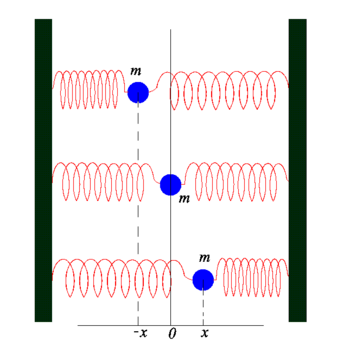Harmonic oscillator (classical)
In classical mechanics, a harmonic oscillator appears frequently as a simple model; it describes approximately many different physical phenomena. In its simplest form a harmonic oscillator consists of a mass m on which a force acts that is linear in a displacement from equilibrium. By Hooke's law a spring gives to very good approximation a force that is linear for small displacements and so figure 1 shows a very simple example of a harmonic oscillator. The uppermost mass m feels a force acting to the right equal to f x, where f is Hooke's constant. The mass in the middle is in equilibrium, and the mass at the bottom feels a force to the left equal to −f x. The spring force always acts so as to restore mass back toward its equilibrium position. If the mass is pulled out of equilibrium and then let go, the mass will (in an ideal setup) oscillate for ever. In practice, energy will be lost due to friction of the atoms in the spring, so that the oscillation will die out after some time.
(To be continued)
